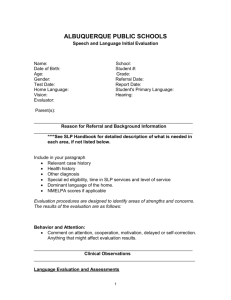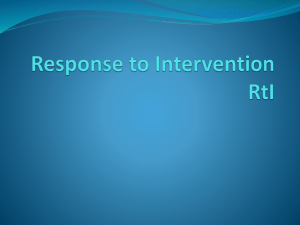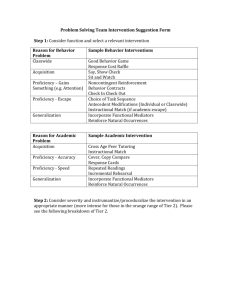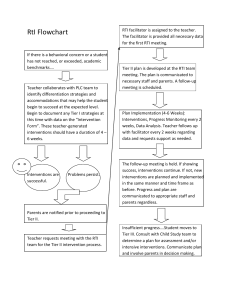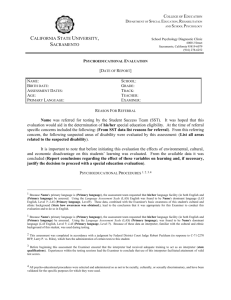1/22/2015
advertisement
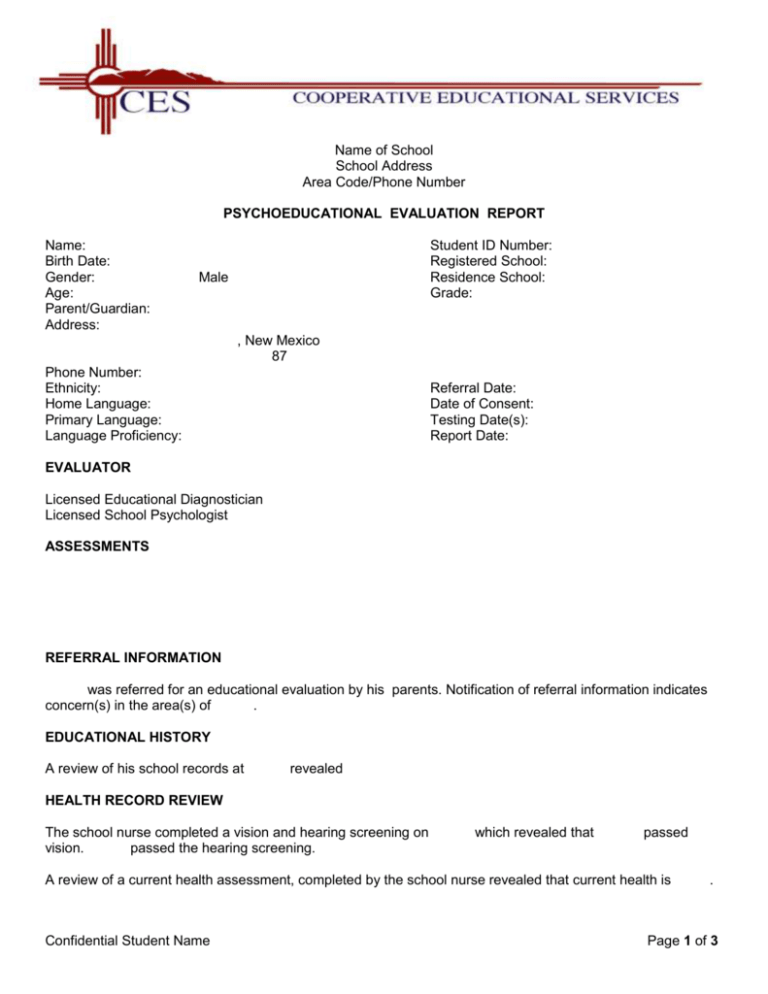
Name of School School Address Area Code/Phone Number PSYCHOEDUCATIONAL EVALUATION REPORT Name: Birth Date: Gender: Age: Parent/Guardian: Address: Student ID Number: Registered School: Residence School: Grade: Male , New Mexico 87 Phone Number: Ethnicity: Home Language: Primary Language: Language Proficiency: Referral Date: Date of Consent: Testing Date(s): Report Date: EVALUATOR Licensed Educational Diagnostician Licensed School Psychologist ASSESSMENTS REFERRAL INFORMATION was referred for an educational evaluation by his parents. Notification of referral information indicates concern(s) in the area(s) of . EDUCATIONAL HISTORY A review of his school records at revealed HEALTH RECORD REVIEW The school nurse completed a vision and hearing screening on vision. passed the hearing screening. which revealed that passed A review of a current health assessment, completed by the school nurse revealed that current health is Confidential Student Name . Page 1 of 3 PARENT INTERVIEW were interviewed in person on . STUDENT ASSISTANCE TEAM The student was presented to the Student Assistance Team by his during Student Assistant Team meeting(s), . According to information collected Tier I interventions were provided in the area(s) of and did make expected gains. Tier II interventions were then implemented. Tier II interventions provide targeted, supplemental, individual, research based support for a student who is performing below expectations and for whom Tier I instruction and interventions have proven insufficient. Tier II Interventions Goals: The following progress monitoring and district assessment information was reported. Name of Assessment Skills Assessed Assessment Date Score Review of Factors Which Could Impact Performance State evaluation guidelines require a review of relevant factors that could impact a student’s progress in the school setting. Cultural, linguistic, environmental and socio-economic are considered. Cultural factors include cultural practices which could impact a student’s performance on a test or in school. Commitment to time, movement, affect, and reliance on the manner in which one communicates are some of the variables considered during the instruction day and testing. Linguistic factors include the student’s dominant language, language spoken in the home, and language(s) of instruction. The student’s first language and exposure to a second language are important variables to consider. The duration and frequency of a second language other than English is subject to investigation to determine if a student has acquired language proficiency in English before attempting to measure academic or intellectual abilities. Environmental factors include conditions, forces, or external stimuli which impinge upon a student’s ability to succeed in the school setting or during testing. Socio-economic factors which could impact health, nutrition, attitude, or exposure toward learning are also reviewed. Confidential Student Name Page 2 of 3 EVALUATION DESCRIPTIONS OF TEST SCORES One or more derived scores are used to report standardized test results. Some of these scores and their definition are as follows: Relative Proficiency Index (RPI) is a criterion reference measure which provides information about the relative predicted ease or difficulty with which a student will be likely to perform similar grade or age level work. An RPI of 5/90 means the student is predicted to perform at a 5% success level while the average peers would perform at a 90% success level. Percentile (%ile) A score that gives the rank of a student compared with others of the same age (e.g. a percentile of 70 means the student’s scores is equal to or greater than 70 out of 100 students of the same age). Age Standard Score (SS) An age standard score is a measure of a student’s standing compared with others of the same age. Standards scores have a mean of 100 and a standard deviation of 15. Age Equivalent (AE) A score that reflects a student’s performance in terms of the age level at which the score falls. An age equivalent of 3-4 means the student made the same score by the average child who is 3 years 4 months of age. Scaled Score This is a type of standard score with a mean of 10 and a standard deviation of 3, typically used to report subtests results for intelligence scales. Standard Error of Measurement (SEM) A standard error of measurement is an estimate of the amount of error associated with a student’s obtained score and is directly related to the reliability of a test. T-Score A T-Score is a standard score based on a distribution with a mean of 50 and a standard deviation of 10. CLASSROOM OBSERVATION ASSESSMENT OBSERVATIONS was evaluated in session(s) at . demonstrated . He did not wear glasses during the testing. Rapport was easy to establish. The testing environment was adequate for the administration of all test instruments. Test results appear to be valid estimates of current skill levels. ASSESSMENTS EVALUATION SUMMARY ELIGIBILITY CRITERIA The Eligibility of Specific Learning Disability is being considered. The Eligibility Determination Team will use the 2011 New Mexico Technical Evaluations and Assessment Manual (TEAM) guidelines to determine eligibility(ies). Determination of eligibility is made by members of an Eligibility Determination Team (EDT) and requires that a student meet evaluation criteria and demonstrates a need for special education services. An EDT meeting will be held to review all available information related to the student. RECOMMENDATIONS Your Name and Credentials Licensed Educational Diagnostician Licensed School Psychologist An interpretation of the results of this assessment was conducted on Confidential Student Name with . Page 3 of 3



